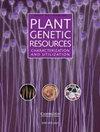印度菜豆(Phaseolus vulgaris L.)产量性状遗传多样性及标记性状关联
IF 0.7
4区 生物学
Q3 PLANT SCIENCES
Plant Genetic Resources: Characterization and Utilization
Pub Date : 2022-10-04
DOI:10.1017/s147926212200017x
引用次数: 1
摘要
普通豆(Phaseolus vulgaris L.)是世界范围内具有高度经济重要性的作物,是欠发达国家人民特别重要的蛋白质和矿物质来源。提高产量是满足由于人口增长而不断增加的粮食需求的一个重要目标。本研究旨在研究印度,特别是喜马拉雅西北地区普通豆农艺性状的遗传结构。利用多态微卫星标记对100份普通大豆材料进行了标记-性状关联分析。基于SSR标记的群体结构分析将材料划分为3个主要亚群体。使用一般线性模型(GLM)和混合线性模型(MLM)方法发现了10个显著的mta。我们发现两个标记BM142和J04555与GLM和MLM方法标记中常见的每株100粒重和荚果相关。所有的mta都被认为是主要的mta,贡献了25%以上的表型变异。本研究发现的重要数量性状位点可用于标记辅助育种,加快普通豆高产品系的遗传改良和发育。本文章由计算机程序翻译,如有差异,请以英文原文为准。
Genetic diversity and marker trait association for yield attributing traits in accessions of common bean (Phaseolus vulgaris L.) in India
Common bean (Phaseolus vulgaris L.) is a highly economically important crop worldwide and a particularly important source of protein and minerals for people in less developed countries. Improving yield is a vital objective to meet the increasing demand for food due to the expanding human population. The present study was undertaken to study the genetic architecture of agronomic traits of common bean in India, particularly in the north-western Himalayan region. Marker-trait association (MTA) analysis was performed in a population of 100 common bean accessions using polymorphic microsatellite markers. Population structure analysis based on SSR markers divided the accessions into three main subpopulations. Ten significant MTAs were found using general linear model (GLM) and mixed linear model (MLM) approaches. We found two markers i.e. BM142 and J04555 associated with 100 seed weight and pods per plant common in both the GLM and MLM approach markers. All the MTAs were considered as major MTAs contributing more than 25% phenotypic variation. The significant quantitative trait loci identified in this study could be used in marker-assisted breeding to accelerate the genetic improvement of yield and development of high yielding common beans lines.
求助全文
通过发布文献求助,成功后即可免费获取论文全文。
去求助
来源期刊

Plant Genetic Resources: Characterization and Utilization
Agricultural and Biological Sciences-Agronomy and Crop Science
CiteScore
2.80
自引率
0.00%
发文量
29
审稿时长
>12 weeks
期刊介绍:
Plant Genetic Resources is an international journal which provides a forum for describing the application of novel genomic technologies, as well as their integration with established techniques, towards the understanding of the genetic variation captured in both in situ and ex situ collections of crop and non-crop plants; and for the airing of wider issues relevant to plant germplasm conservation and utilisation. We particularly welcome multi-disciplinary approaches that incorporate both a technical and a socio-economic focus. Technical aspects can cover developments in technologies of potential or demonstrated relevance to the analysis of variation and diversity at the phenotypic and genotypic levels.
 求助内容:
求助内容: 应助结果提醒方式:
应助结果提醒方式:


